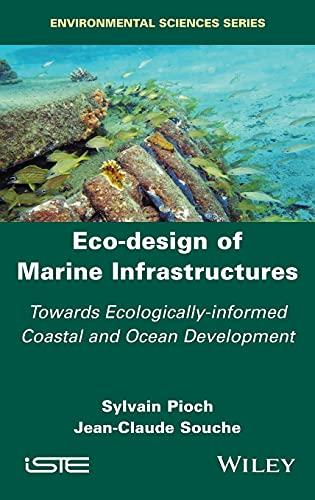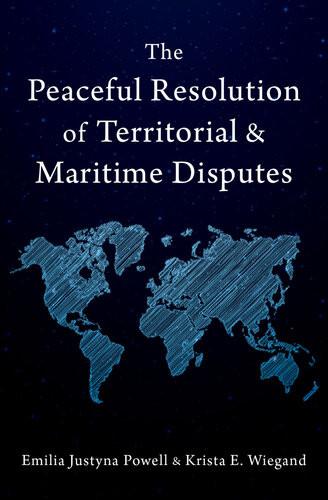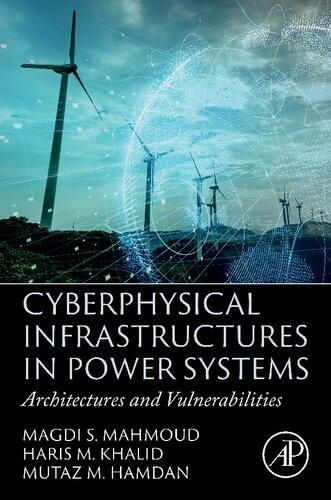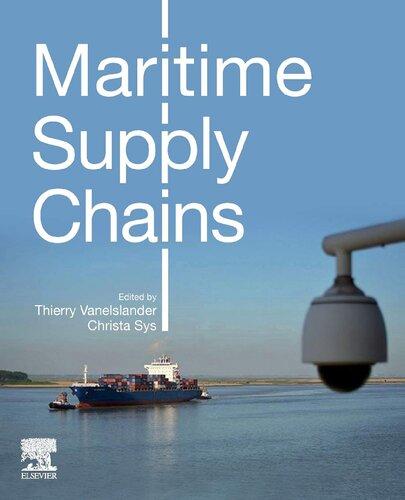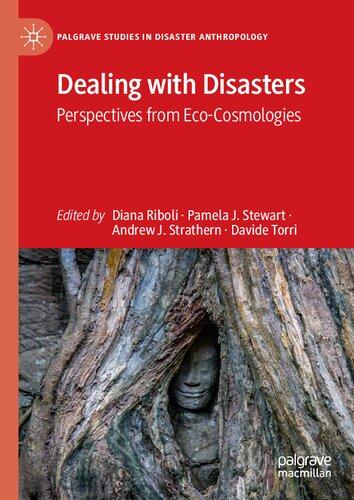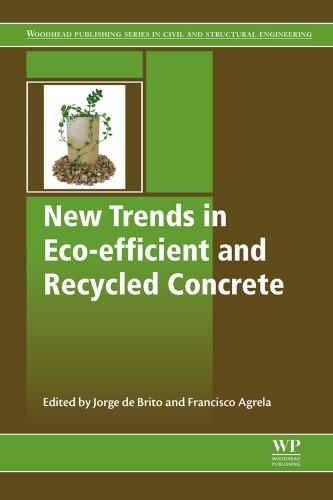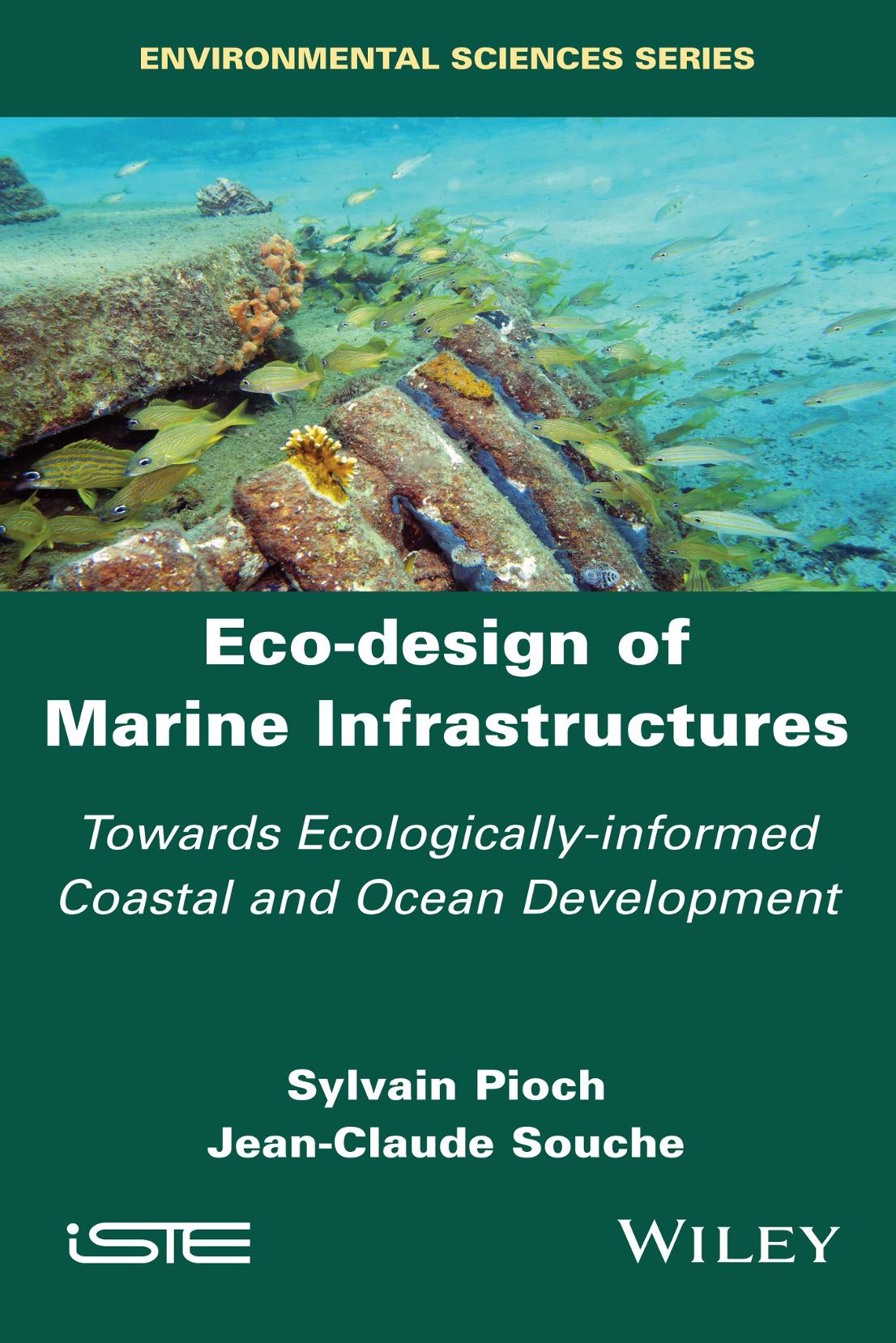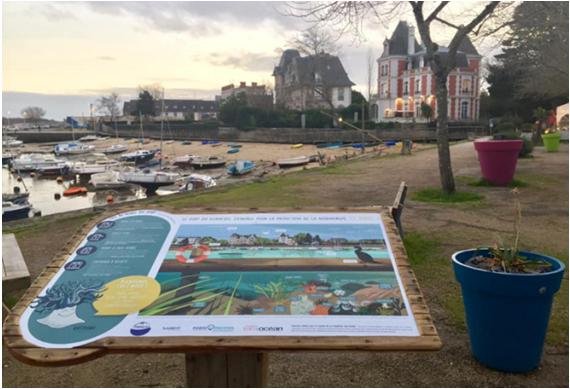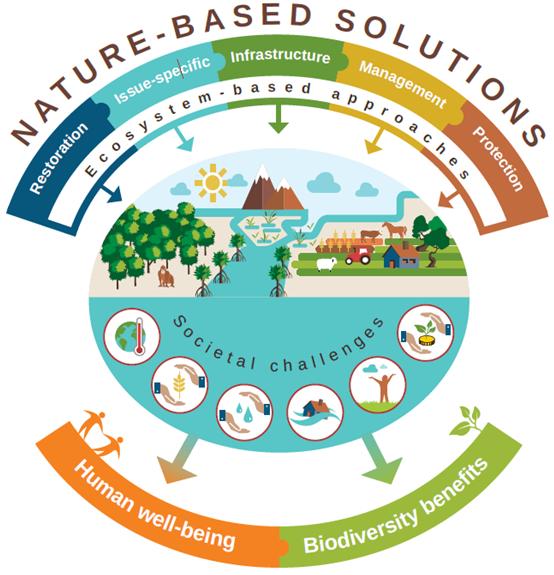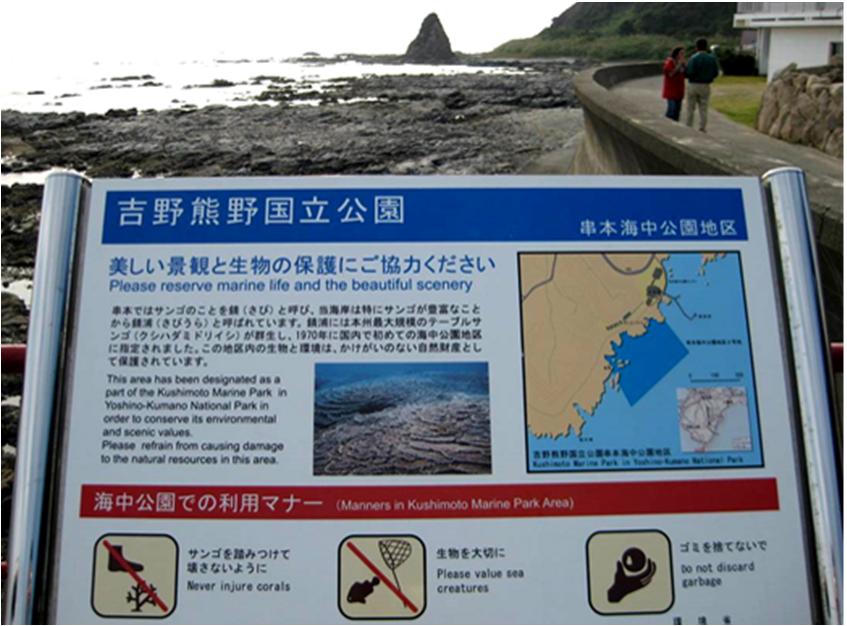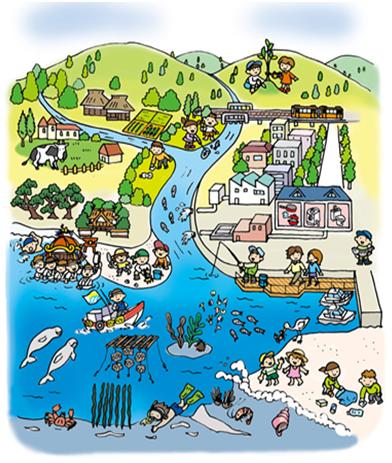Eco-design of Marine Infrastructures
Towards Ecologically-informed Coastal and Ocean Development
Pioch
Sylvain
Jean-Claude Souche
First published 2021 in Great Britain and the United States by ISTE Ltd and John Wiley & Sons, Inc.
Apart from any fair dealing for the purposes of research or private study, or criticism or review, as permitted under the Copyright, Designs and Patents Act 1988, this publication may only be reproduced, stored or transmitted, in any form or by any means, with the prior permission in writing of the publishers, or in the case of reprographic reproduction in accordance with the terms and licenses issued by the CLA. Enquiries concerning reproduction outside these terms should be sent to the publishers at the undermentioned address:
ISTE Ltd
John Wiley & Sons, Inc.
27-37 St George’s Road 111 River Street London SW19 4EU Hoboken, NJ 07030
UK USA
www.iste.co.uk
www.wiley.com
© ISTE Ltd 2021
The rights of Sylvain Pioch and Jean-Claude Souche to be identified as the authors of this work have been asserted by them in accordance with the Copyright, Designs and Patents Act 1988.
Library of Congress Control Number: 2021940543
British Library Cataloguing-in-Publication Data
A CIP record for this book is available from the British Library
ISBN 978-1-78630-711-8
1.2.
1.3.1.
1.3.2.
1.3.3.
1.4.
1.5.
1.6.
1.6.1.
2.2.3.
2.2.6.
2.2.7.
2.3.
2.3.1.
2.3.2.
2.4.
2.4.1.
2.4.3.
2.4.4.
2.4.5.
2.5.
2.5.1.
2.5.2.
2.5.7.
3.1.
3.2.1.
3.2.2. Development and maturation of an eco-designed development
3.3. The methodological approach to eco-design: responding to the expressed need ......................................
3.3.1. Eco-design, an adapted technical response for engineers and project managers
3.3.2. Eco-design as a lever for modernizing the execution of works
3.3.3. Monitoring, control, validation and satisfaction for the user and nature
3.4. Infrastructure as a new support for marine life
3.4.1. Biophysical data of the environment
3.4.2. Integration of the infrastructure into an ecosystem..............
3.4.3. Bio-inspiration and design of eco-designed
3.5. Eco-design at the material level: the example of concrete ............ 144
3.5.1. A little history .................................. 144
3.5.2. Concrete, the state of the art .......................... 150
3.5.3. Concrete formulations ............................. 156
3.5.4. The integrative eco-design of the performance approach: perspectives ....................................... 159
Chapter 4. Evidence Through Experience: Examples of Eco-designed Marine Projects 163
4.1. Mayotte submarine pipeline: an initial eco-designed marine structure ..... 167
4.2. Bio-inspiration and nature-based solutions for artificial reef design ...... 177
4.2.1. The value of creating artificial habitats .................... 178
4.2.2. The issue of fish habitat creation ....................... 179
4.3. The scope of port eco-design ............................ 183
4.3.1. The concept of port eco-design ........................ 183
4.3.2. Eco-design of the port of Guilvinec-Lechiagat ................ 185
4.3.3. Ecological structures designed as natural grass beds ............ 186
4.3.4. “Calais Port 2015” port project ........................ 187
4.4. Eco-design for coastal protection .......................... 191
4.4.1. Beneficial use of coastal sediment transport: the Sand Motor project ... 192
4.4.2. The experience of the ECOncrete company ................. 194
4.4.3. Landscape redevelopment of the East Darling Harbour waterfront in Sydney ........................................ 196
4.4.4. CLI’s experience with concrete dike shells: the need for eco-design .... 198
4.4.5. Eco-design of the Brest harbor breakwater .................. 200
4.5. Biomimetic artificial reefs in Corsica (Ajaccio) ................. 202
4.6. Artificial island eco-design ............................. 208
4.6.1. The Monegasque government’s vision for the Principality of Monaco’s offshore extension ............................. 208
4.6.2. The genesis of the eco-design of the Monegasque artificial peninsula project .................................... 214
4.7. Eco-design of mooring systems .......................... 216
4.7.1. Eco-design of moorings for recreational vessels in Guadeloupe ...... 217
4.7.2. Eco-design of moorings for large vessels and yachts as a solution for the protection of the Mediterranean Posidonia meadow 225
4.8. Eco-design of offshore viaduct piles ........................ 232
4.9. Offshore wind farm project eco-design: multi-use perspectives ......... 236
Foreword
Grown-ups never understand anything by themselves, and it is tiresome for children to be always and forever explaining things to them.
Antoine de Saint-Exupéry
Our planet and our ecosystems are in danger and we must act. Of course, we hear this message every day and most of us are now aware of it. However, it is not easy to exactly identify the different challenges ahead, and it is even less easy to act accordingly.
Intended for a wide audience, this book can help provide answers. It presents, through concrete examples and testimonies, an exhaustive state of the art allowing everyone to better understand marine eco-design and the issues it addresses. It also proposes a methodology for acting differently. Although this book is primarily intended for technicians, engineers, scientists and students, it may be of interest to anyone who is curious to see how we can “develop” by taking inspiration from nature. For this book is not only the story of two men of art, it is also the work of two marine enthusiasts who, for more than 30 years, have been working for the preservation of the seabed; passionate people who have spent hundreds of hours in the water observing, marveling at marine life and trying to understand the combination of elements and the consequences on biodiversity. I have shared this passion with them for many years.
Through this book, Sylvain and Jean-Claude, who are great professionals and long-time friends, will share their universe with you. Through concrete experiences, you will discover the marine world, see through their eyes the underwater biotope and how to preserve it and perhaps feel its mysteries in order to reconcile what seems irreconcilable: the human impact of a maritime infrastructure and the preservation of biodiversity. Sylvain Pioch combines both a sixth sense of this wilderness and an
exceptional scientific knowledge. His ability to understand and predict the behavior of fish and marine life will always amaze me. He is, at the same time, a renowned professor, a researcher and a talented designer, recognized throughout the world. Jean-Claude Souche is the one who makes it possible to transform concepts into sustainable developments and infrastructures. Today, Jean-Claude is a professor at IMT Mines Alès, a French engineering school, where he heads the civil engineering and sustainable building department. His international experience in marine works, his operational background as an engineer and doctor and his unwavering will to move forward make him a valuable person. With their common conviction, on a professional level, Sylvain and Jean-Claude are incredibly complementary. In this book, they have produced a thorough work on the eco-design of marine infrastructures, which for them is definitive work. This book highlights one of the great challenges of our century, that of preserving marine biodiversity through our land use planning policy and the construction of coastal and port infrastructures. The protection of the environment in terms of maritime development is no longer based on simple compensatory measures, but must, by definition for any project, preserve and promote the development of life and its diversity. I am deeply convinced that project owners, engineers, scientists and contractors can and must play a major role in promoting biodiversity and thus protecting the marine environment. One of the major challenges to come will be to know how to create industrial policies that are economically efficient and respectful of our environment. It is no longer a question of opposing environment and economy or human technology and nature, but, on the contrary, of reconciling them. This requires skill and conviction. Even though science and technology are not the only solution to the problems of today’s world, they provide technical innovation that can lead to changes in human behavior. This is the goal of this book, to allow as many people as possible to understand the stakes, to act intelligently and, finally, to think differently.
Also, throughout these pages, I urge you to think about what we will leave to future generations, I urge you to become the children of the Little Prince because it is possible to change the world, provided we all change, provided we first change ourselves.
Enjoy reading this book.
Régis DUMAY Deputy Managing Director,
Egis
Preface
The distance of man’s emancipation from the sea is equal to the distance of our cells from the composition of sea water.
Loren Eiseley
The purpose of this book is to strengthen the path towards a coastal maritime management where civil maritime engineering is intimately linked with environmental engineering, within a socio-ecosystem where humanity is an integral part of nature. The multiple consequences of the mistreatment of nature by a denatured human will not be discussed in this book. Indeed, it seems to us that the links between the artificialization of the seabed, climate change, pollution, the introduction of invasive species or the overexploitation of natural resources with a deregulated, predatory and irresponsible anthropic activity for the future of ecosystems and the survival of humanity (on our unique Earth) are obvious (IPBES 2019). Neither are we prophets, as the concepts discussed here have already been the subject of modern works (Belknap et al. 1967; Falque 1972; Tarlet 1977) or of older, empirical findings, where humans have also illustrated themselves in their capacity for positive interactions with nature (McHarg 1969; Lassus 2002).
The geographer and planner McHarg (1969)1 detected that in our current modern societies (since the second half of the 20th century), technicists, industrialists and urbanists have an attitude to the human that is dissociated, pre-Copernican and dominant towards nature. The source of this segregative reflection is that we have been fed by an ancient instinct of revenge towards nature, born of a 1,000-year-old resentment of having held so little influence before nature. Psychoanalysts would
1 The work of McHarg in the area of landscape architecture, gathered in his famous Design with Nature, served as a basis for our extrapolation to the submerged, underwater marine domain.
call this a “complex of cultural inferiority, with perverse aggressive tendency”, that is, without consideration, nor empathy, nor feeling for the tormented object. This conception of nature, which is the subject of our predation, would satisfy the desire for primacy buried deep within the human being, for a long time inoffensive since impossible to achieve technically. How can we make this resentment, which we have historically inherited as a consequence of our environment, null and void? How can we prevent it from poisoning the objective of survival and evolution of a human who can now “stand up among the other forms of life” (McHarg 1969)? The expression of our work on eco-design is rooted in our enthusiasm to assert our talents as creators, rather than those of destroyers who are less worthy to represent responsible humans, the managers of their environment and thus of their future.
This exercise is, moreover, made difficult by the Western conception founded on an anthropocentrism disassociated with nature, notably spiritually (Berque 1986). The oriental approach, for example, the Japanese approach using Tao, Shinto or Zen, has sometimes ignored the human as an individual to focus on the human within nature (the garden being the metaphysical symbol par excellence).
In short, two reverse postulates exist: in the West, the human at the expense of nature, and, in the East, nature at the expense of the individual human. The third view would be that of a balance, which does not mean a fusion, where the human is considered as an individual, rather than as a species, within nature.
To date, however, this way has not been expressed in human “works” presented on the maritime domain (principally the submerged part), which have never taken into account natural facts in their intrinsic conception. It is the human against nature, which is understood in maritime engineering as a vocabulary of work or technique: works of defense against the sea, breakwaters, dikes, wave-breaking walls, seawalls, dredging, etc.
On the contrary, land constructions have long been based on a local empirism (the vernacular), allowing humans to observe nature and to settle there harmoniously. The low stone walls follow the curves of hillsides where the peasantry, better than any other profession, know by observation how to exploit and manage the land. There are also our medieval “circulade” Mediterranean villages, where the air circulates wonderfully and naturally refreshes the shaded alleys, offering nesting boxes to swallows and swifts feasting on mosquitoes near the houses. Contrast this with the modern suburbs on the outskirts of these same villages which are asphyxiated, overheated by increasing heat waves and have often disfigured the harmony of the landscape.
We are convinced that the construction of structures must be sensitive to the laws and needs of nature, to ecosystems, to materials and forms adapted to human needs and to the beauty of life, and thus offer sustainable achievements. Eco-design will therefore be adapted to the place and will bring long-term benefits to humans and nature. It is based on ecology, from the Greek oikos, or house, that is, the science of the dwelling, an obvious prerequisite for any development whose objective is to arrange with order (and according to the rules of ecology, of the human in nature) human settlements, with a view to sustainable and desirable development: managing life to ensure our survival.
The temptation and the drift towards a cosmetic nature, a simple green washing, is always present, but a detailed knowledge of the natural functioning and of the typical ecosystem for each site and each project, targeting an integration between the ecological and aesthetic landscape, as well as an ecological follow-up of the developments, are the guarantees to keep a good course. We will have at least tried to advance the notion that the human can play the role of positive creator for their environment, improving the biosphere with new symbioses of humans in nature.
In this work, we propose to focus on marine structures. Indeed, coastal structures, although not specifically designed for this purpose, generate new biotopes that are particularly attractive for coastal species at the juvenile stage: for example, 30–109 times more juveniles are welcomed on dikes and harbors than on natural rocky habitats in the western French Mediterranean (Pastor 2008).
However, these ecological potentialities are ignored, or at best incidentally recognized and very rarely enhanced by specific eco-designed and nature-inspired infrastructures. Marine works are generally designed with regard to functional, technical, economic or hydro-sedimentary marine environment considerations, not as supports to maintain or increase marine biodiversity.
The objective is now to develop their functional aspects from an ecological point of view so that the structure becomes a proactive element for the environment. It becomes part of a dynamic ecosystem by creating habitats and ecological functions: shelter for juveniles, feeding areas, habitats for fixed fauna and flora, etc.
This book first offers the reader two chapters related to the developments in the fields of environmental regulation and maritime civil engineering, increasingly expressing a social expectation towards the prefix “eco-”. Indeed, every planner must design a facility in response to a functional and technical need, meeting regulatory standards.
However, beyond this “classic” approach to marine development projects, the eco-design approach presented in Chapter 3 allows environmental impacts to be taken into account from the technical definition of the works. The authors illustrate this approach in Chapter 4 with practical examples that they have dealt with, complemented by feedback from projects carried out according to these principles and attempting to avoid running the risk of justifying avoidable projects by their “green” appearance. It is always preferable to abandon a project if its negative effects on the environment are unavoidable, because offset is a Trojan horse for the development that is thus facilitated, as denounced by Firth et al (2020): “Greening of grey infrastructure should not be used as a Trojan horse to facilitate coastal development.”
Sylvain Pioch
Jean-Claude Souche
July 2021
Acknowledgments
This book is dedicated to our families: Élise, Guilhem, Céleste, Raphaëlle and Julianne, and Sophie, Juliette, Rémi, Éloïse and Alexis, who are the driving force of our lives. We would also like to thank all those who, through their lives, actions and convictions, seek to build a fairer and more beautiful world where humankind will be able to consider all the other forms of life on the planet of which it is only the host.
This book is the compilation of 30 years of professional practice acquired as an environmental engineer in planning and impact studies (S. Pioch) and as a civil engineer (J.-C. Souche), then as lecturers and researchers in University Montpellier 3 and Mine Telecom Institute of Alès or simply as divers.
Beyond our common passion for the sea, it seemed unavoidable to merge our experiences as the need to design and build marine structures differently is urgent. It is also with modesty that we propose this work to readers, without claiming it to be exhaustive or the absolute truth. We simply provide a testimony and methodological tracks that we have tested in the field, with actors involved in development.
We would like to thank Régis Dumay, Marie Salgues, Jean Bougis, Philippe Saussol and Jean-Marie Miossec for their active help in the elaboration of this book, as well as the company Beuchat for the diving equipment. A special thought for Françoise Gaill for her constant support. We would also like to thank all the contributors who shared their testimonies with us in order to make this book a moment of sharing of experiences in France and abroad, which we hope the readers will appreciate:
– Alexandra Agostini, Anne Rioux, Aurore Léocadie, Osanne Paireau, Katherine A. Dafforn (Australia), Louise Firth (UK) and Shimrit Perkol-Finkel (Israel);
– André Grosset, Bernard Sigros, Cyril Giraudel, Cyrille Taioni, Etienne Cunge, Fabrice Javel, Frédéric Martarèche, Jean-Louis Gaziello, Jean-Michel Cathala, Michel Fons, Patrick Guiraud, Pierre Roy, Romaric Vicente, Marcel Stive (Netherlands), Jean-Luc Nguyen (Monaco) and Richard Spieler (USA).
May this modest work inspire us to think differently and to eco-design marine works, for the mutual benefit of the sea and humankind.
Principles and Genesis of Maritime Eco-design
The global ecological crisis is concomitant with the Anthropocene, this new geological era in which humans have become the central actors of pressures on the planet (Crutzen 2006). Indeed, the recent IPBES report (IPBES 2019) makes a damning assessment of the state of biodiversity since the beginning of the industrial era two centuries ago: 75% of the land has been altered by humans (one-third of the land consuming three-quarters of the available water resources is agricultural), 66% of the oceans are threatened by humans and more than 85% of wetlands have been destroyed. It is therefore our actions on this unique planet that are holding back our own future. The logic of this observation would lead us to stop, or at least to slow down, the well-known causes of this disaster (in decreasing order): (1) artificialization and land use; (2) resource exploitation (fishing, forestry, etc.); (3) climate change; (4) pollution (plastics, chemical residues, etc.); and (5) invasive species (IPBES 2019). Thus, artificialization and land use would be our main problem. In addition to agriculture, it is the issue of urbanization and its consequences (cities, ports, mines, industries and roads) that is the most important because it leads to an artificialization of environments that is difficult to reverse. If we look at the forecasts, we can see not only a continuity but also an acceleration of global urbanization, both on the continents and at sea. No less than 60,000 billion US dollars will be invested in infrastructure between 2019 and 2040 (in the 56 countries representing 88% of the world’s GDP (Global Infrastructure Hub and Oxford Economics 2017)), more than 1.2 million km² will be urbanized by 2030, in just 10 years, that is, an increase of 185% compared to 1970–2000 (Seto et al. 2012), and 3–4.7 million km² of roads will be created by 2050, an increase of 25% compared to the current annual rate (Meijer et al. 2018).
Eco-design of Marine Infrastructures: Towards Ecologically-informed Coastal and Ocean Development, First Edition. Sylvain Pioch and Jean-Claude Souche. © ISTE Ltd 2021. Published by ISTE Ltd and John Wiley & Sons, Inc.
This phenomenon is particularly prevalent in coastal areas, as 8 of the 10 global megacities are located on shores, such as Lagos, Tokyo, Jakarta and New York. The global maritime infrastructure footprint was approximately 32,000 km² in 2018 (Bugnot et al. 2021). It is expected to reach 39,400 km² by 2028, a territory equivalent to the state of Bhutan! However, the area of seascapes impacted by these structures was also estimated to be between 1 and 3.4 million km² in 2018, with an increase of 50–70% expected by 2028, which is comparable to the global extent of urbanized areas (estimated at 0.02–1.7% of the land mass (Bugnot et al 2021)). On the French coast, the rate of occupation doubled between 1965 and 19801. Between 2000 and 2006, no less than 6,809 ha were destroyed for the construction of harbors, dikes, embankments and other structures2. For example, in Hérault, a department in the Occitanie region, close to the Mediterranean Sea (southern France), the level of urbanization in 2015 on a narrow coastal strip of 15 km was close to 70%, with no less than three-quarters of the population concentrated there (DREAL Occitanie). In the international literature, we speak of a global “coastal squeeze”. This phrase, introduced by Doody (2004), is based on the threat to coastal development caused by the dual effect of rising sea levels and the explosion of human activities. There is an incoherence between human and the needs of our planet, especially in the urgent matter of the artificialization of natural environments, notably coastal ones. Urbanization remains the result of a development that is still too predatory of space.
Faced with the enormous challenge of a renaturation of culture (Pelt 1977), for a livable future of humankind, it becomes crucial to improve the consideration of biodiversity in territorial planning projects. We will focus here on the potential for nature-friendly planning, trying to integrate its functional needs as a fully-fledged objective in the design of infrastructures.
1.1. Principles of maritime eco-design
The actions taken to allow for the “natural” environment (we will use this term here in relation to the word “ecosystem”) for the operation of maritime works are varied. In the case of ports, these include the control and reduction of discharges, energy, sediment, waste and water management, environmental management plans (compliant since 2013), natural infrastructure master plans – including a natural heritage master plan – and Natura 2000 operators within the port perimeter (e.g. the Grand Port Maritime of Dunkirk).
1 MEDAM (2015). Database for the French Mediterranean Coast (Inventory and Impact of Land Reclamation).
2 Ibid.
Principles and Genesis of Maritime Eco-design 3
At the same time, several tools designed to provide (voluntary) environmental certification are also available to project owners: AFAQ Clean Ports, ISO 14001, Blue Flag and the latest “Clean Port” certification active in biodiversity3, in March 2018. These certifications are often accompanied by communication programs, such as the “Green Port”4, “Year of Biodiversity” and “Port Biodiversity Index”, or information panels and stands proposed by the ports’ sustainable development departments, suppliers of “eco-” equipment or operators (Figure 1.1).
Figure 1.1. Public presentation panel on port biodiversity in the port of Kernével, one of the first two ports in Brittany to be certified “Clean Ports Active in Biodiversity”5 in 2018 (photo: ©APPB)
Political actions or the dissemination of good environmental practices have been strengthened in recent years. At the international level, for example, we can cite the Working with Nature program (from the International Association of Ports and Canals, 2008), based in particular on the experience of Port 2000 in Le Havre and the numerous guides produced PIANC6 (2011a, 2019, 2020); the World Harbour Project7 (Steinberg et al. 2016), which brings together 15 ports around the issues of ecological engineering, nature-based solutions and the resilience of natural port
3 This AC J81-032 certification of March 2018 is an optional component that adds to the requirements of the “Clean Ports” CWA AC J 81-030 standard and is part of a prior European “Clean Ports” certification process.
4 http://www.greenport.com.
5 http://www.portsdebretagne.fr/actualites/deux-ports-bretons-certifies-ports-propres-actifs-enbiodiversite-roscoff-bloscon-et-kernevel/.
6 The World Association for Waterborne Transport Infrastructure (PIANC), the oldest international professional organization in the port field: https://www.pianc.org.
7 http://www.worldharbourproject.org.
environments; at the European level, the CWA 16987 (Clean Harbour Guidelines); and at the national level, the reflections initiated as part of the Grenelle mission on the “Port of the Future” (led by CEREMA8), or regional variations, such as for the major seaport of Marseilles and the “GIREL”9 research program, which was carried out in 2010.
In spite of these virtuous impulses, in the field, during the first design phases of a project, the objectives are primarily to propose a structure that meets technical constraints (resistance, durability) with a controlled cost, aligned with socio-economic objectives that meet a functional need: a marina or a commercial port, an offshore wind turbine, a breakwater, an offshore wastewater treatment plant, etc. The environmental question is applied to justificatory and secondary considerations which are dealt with once the technical and socio-economic choices have been made, under regulatory “constraint” (Airoldi et al. 2021).
This is where the purpose of eco-design, or oekodesign10, takes root, for its objective is to design a project, from sketch or feasibility phases (within the meaning of Act no. 85-704 of July 12, 1985, on public contracting and its relationship with private contracting, known as the MOP Act), according to ecological performance or co-benefit objectives. The aim is not to “wipe the slate clean” for the past but, based on technical engineering knowledge, to introduce biophysical considerations, in connection with the need to protect and develop the natural environment in the project to develop the sea.
1.2. Definition of eco-design of marine infrastructures
The eco-design of marine infrastructures is the result of recent cultural evolutions, as mentioned above. It is part of the interdisciplinary field of ecological engineering, which includes human sciences (geo-planning, law), engineering sciences (civil engineering, materials science) and natural sciences (biology, ecology). It responds to a major challenge for responsible human societies and biodiversity managers.
For Francis and Lorimer (2011), reconciling human and non-human in the project of developing urban territories, by integrating the conservation of nature, is undoubtedly the greatest challenge of the 21st century. For these same authors, the
8 Center d’études et d’expertise sur les risques, l’environnement, la mobilité et l’aménagement (previously CETMEF, before 2014).
9 See Chapter 4 of this book on the GIREL project at the port of Fos-sur-Mer.
10 We prefer this term to the one used in most English-language eco-engineering publications due to its proximity to the approach of project management for the design of a development project, even though they both designate the same field of reflection.
contribution of ecological engineering, a discipline that is still in its infancy in terms of the solutions it proposes, is a decisive factor in ecodevelopment. It was Odum, in 1962, in the context of his work on energy flows in marine ecosystems, who proposed the term “ecological engineering” (Odum et al. 1963). The most widely accepted definition today is that of B. Mitsch, a student of Odum, associated with S.E. Jørgensen (Mitsch and Jørgensen 1989): “Ecological engineering uses ecology and engineering to predict, design, construct or restore, and manage ecosystems that integrate human society with its natural environment for the benefit of both.”
The intimate link between ecology, land use planning and civil engineering is underlined by Van Bohemen (2004) who makes it the key to its diffusion and application. According to Bergen et al (2001), the design of development projects must integrate the issues of human societies in an ecological approach, for a mutual human–nature benefit, following steps that ratify its application, the first three of which are:
1) design in accordance with ecological principles;
2) design adapted to the environmental specificity of each site;
3) maintaining the functional requirements of the structures, regardless of environmental requirements.
While ecological engineering includes eco-design in its definition, this term seems important to us because it underlines a crucial aspect in the success of a project benefiting human and nature; that is, to apply ecological concerns at the feasability step, to guide the project design from the beginning. Indeed, all too often, so-called eco-designed infrastructures take into account environmental aspects once the technical-economic aspects have been resolved (Figure 1.2).
According to the French engineers’ union Syntec Ingénierie, this approach can be defined as follows: “Eco-design is the technical design of projects by also considering global and local ecological concerns”. It is “an approach that can be applied to a large number of sectors, without generating additional costs in the long run” (Les Cahiers de l’Ingénierie 201011).
We will complete this definition with the idea that ecological added value can also improve the technical performance of a structure, as a co-benefit. This would be the case, for example, of a desired effect of bioprotection of an eco-designed quay enabling, by its colonization, the promotion of protection of concrete from chloride ions (gain on the aging of the structure which is avoided).
11 http://www.syntec-ingenierie.fr/actualites/2010/09/01/les-cahiers-de-lingenierie-n80septembre-2010/.
Figure 1.2. Eco-design project methodology (top blue arrow) compared to a standard approach (middle slice of the figure)12. For a color version of this figure, see www.iste.co.uk/pioch/marine.zip
We will therefore propose as a definition of eco-design of marine infrastructures the process of “designing sustainable maritime development projects with precise/specific technical and ecological functions13, which generate socioecosystemic co-benefits, without generating additional costs in the long term”.
It also seems important to us to address an aesthetic aspect for better integration into the underwater landscape. The aesthetic question of an object placed within a still “natural” environment, the seabed, seems essential to us. Indeed, addressing the “classic” needs of development meets precise rules of art, currently the subject of specifications, never integrating values of landscape aesthetics. However, the “beautiful” and “good” are always at the center of the concerns of humans, when they have the ambition to see their creations endure in the objective of being “well-made” and when they have the financial means to fully undertake this ambition. The morphologies of submerged elements are resolutely human and far from the soft forms usually found under the sea: cubes, trapezoids, beams, chaotic heaps, etc. A landscape approach would allow a better visual integration of these developments under the sea and undoubtedly a better acceptance of projects by the concerned actors and the general public. The contributions of bio-inspiration, more modest than the idea of biomimicry, can also usefully be called upon here, not only in terms of mechanisms that favor biodiversity (roughness, quality of materials, etc.), but also in terms of the overall visual aspect of a structure in a natural underwater environment. An eco-designed structure is a structure whose forms are bio-inspired and which
12 The eco-design approach begins in the early stage of the project, in comparison with usual eco-engineering treatments which are based on mitigation resulting from environmental impact assessments or ecosystem damage. They are mainly considered after the design of the project to reduce or offset significant negative impacts.
13 Specific, therefore assessable, quantifiable, required; specific, therefore adapted to each site or type of project requested.
Principles and Genesis of Maritime Eco-design 7 integrates ecosystem conservation objectives into its functions, as well as its technical functions.
PIANC also emphasizes the need to design works according to the concept of sustainable development and publishes professional recommendations with this in mind (PIANC 2011a). This is the idea of “working with nature”, developed by Dorien Korbee, which is defined as: an integrated process which involves working to identify and exploit win-win solutions which respect nature and are acceptable to both project proponents and environmental stakeholders. It is a philosophy which needs to be applied early in a project when flexibility is still possible (PIANC 2011b).
Nature-based solutions, popularized by the International Union for Conservation of Nature (IUCN), include infrastructure eco-design in their definition (CohenShacham et al 2016): “Nature-based solutions are actions built on ecosystems to address global challenges such as climate change or natural risk management”, for example, the biogenic seawall for coastline protection (Figure 1.3).
Figure 1.3. Diagram of the definition of nature-based solutions, proposed by the IUCN, where “conventional” infrastructure is cited as an application (Cohen-Shacham et al. 2016). For a color version of this figure, see www.iste.co.uk/pioch/marine.zip
Internationally, our definition of eco-design is related to the terms “green engineering”, “eco-engineering”, “nature-based solution” and “eco-design” (Pioch et al. 2018). It now seems interesting to us to better draw the spirit of this approach from the sources of inspiration of eco-design dedicated to marine environments, through the Japanese experience.
1.3. Japanese inspiration
It is in Japan, an archipelago country turned by necessity towards the sea, where the observation of nature is an art as much as a deep aspiration, that the ideas on the development of the seabed have been developed.
It was around the 17th century, during the reign of Emperor Jôo, that fish houses, reefs and artificial fishing habitats were built near the coast. It is within this culture of Sato-umi, literally “the sea where people live”, and this vision of a fertile and rich sea for those who know how to change it that the Japanese idea of eco-design was developed (Yanagi 2012).
The very root of the word œkodesign (oikos, from the Greek word for home or house) is completely in line with that of Sato-umi, based around the notions conveyed by ecumene14 and ecology. We can also find in this vision the inspiration developed by Rosenzweig and Michael (2003) for the ecology of reconciliation, where biodiversity and human development are closely intertwined in our “common home”.
1.3.1. Influence of the Japanese vision for sea-friendly development projects
François Doumenge15, in his book Le Japon et l’exploitation de la mer (1961), was impressed by “the incredible creativity of this people towards maritime productive development”. He emphasized the empirical and traditional approach of Asian societies, where the observation of nature, expressed in the Shinto spiritual tradition (or Kani-michi, the “voice of the gods”), gave a familiar closeness between humans and a deified nurturing nature, but in proximity, not in superiority (Doumenge 1961, 1966). In fact, the spirituality developed around nature and Shinto is more a way of life than a religion in the Western sense, according to Doumenge. This vision has also influenced Augustin Berque (1996). He admits in his reflections
14 The relationship of humanity with the Earth’s expanse.
15 Of the Languedoc Geographical Society.
to having been inspired by the Japanese author Watsuji Tetsurō to clarify his vision of the ecumene where the human is intimately dependent on the natural environment. The sea (umi) is both a vital and respected environment because it is a place of intense spiritual activity where the kani (familiar deities) live and where the souls of the dead spend time. The Japanese view of the sea, and the underwater world, is also one that is comparable to our view of our earthly, poetic and scenic landscapes (Figure 1.4).
Moreover, the two basic principles of Japanese coastal maritime law (Amako 2015) are based on:
– the “Yoro Code” (養老律令 enacted in 757): “coastal areas are of common (public) use and are managed by the users themselves”;
– the “Ritsuryo Rules” (律令要約 enacted in 1741): “coastal areas are managed by delegation to local fishing communities”.
The management of natural marine environments closest to the activities carried out there, in this case fishing, is a marker structuring Japanese thinking.
Figure 1.4. Kushimoto Marine Park, protected for the value of underwater landscapes (photo: S. Pioch)
1.3.2. The Japanese Sato-umi
This particular view, and the predominance of the sea, is explained by the geography of Japan, made up of five large islands and 6,847 islands and islets. The exclusive economic zone (EEZ) of Japan, with 4,050,000 km², is also the sixth largest in the world.
With only 14% of the country’s land area available as arable land, the submerged volume of the sea has long been an essential element in providing the country’s food resources, along with rice cultivation. The ICZM vision is therefore naturally developed in Japan under the term Sato-umi (Figure 1.5).
The term was proposed by Yanagi; it comes from its terrestrial counterpart Satoyama, where sato refers to a place where people live and yama to a forest; the combination of the two terms then leads to a third definition: “the forest near the place where people live”. Sato-yama came from a reaction that we might call neo-modernist, questioning the idea that nature would reach its fullest potential without the work of humans (Dublin et al. 2014). This is what is developed by Lassus (2002) in his book Harmonie et règles urbaines, where the work of humans respects biodiversity, creating different interactive biotopes.
Figure 1.5. The concept of Sato-umi, where humans interact with the aquatic environment for mutual benefit: (a) Japanese Ministry of the Environment (2015); (b) Yanagi (2007)
This idea of Sato-umi, close to the European vision of ICZM16, reinvests the contributions of ecological engineering to integrate nature into the design of infrastructures.
1.3.3. Artificial marine habitats: Japanese origin of inspiration for eco-design
Japan is undoubtedly considered as the world leader in the successful management of the seabed, as much in terms of application (stability of coastal fisheries) as perspective (Bailly 1989; Baine 2001). Extensive coastal mariculture (or marine-ranching) began with the great interest of this maritime nation in the creation of “fish houses”, habitats adapted to the needs and functions necessary to increase underwater life. Thus, the first Japanese reefs, or artificial habitats (AHs), were described between 1652 and 1655 (during the reign of Emperor Jôo). They consisted of wrecks filled with stones to extend the exploitable fishing areas near the village. The technical description is very precise, and the choice of materials (stones and timber from ships) is linked to questions of habitat (volume, ecological functions, target species, stage of development) and durability. However, it was not until the 20th century that this structural diversity really developed in Japan, and then from the 1950s onwards for the rest of the world.
The first modern (disseminated) Japanese studies on AHs date back to 1903 (Fukuoka Prefecture), with the most important trials starting in 1952 with the first governmental plan for “development of shallow water fishing areas” (Simard 1996). The Japanese public investment for the creation of AH infrastructures in 2007 alone was 602 million euros (93.318 billion yen), with an average between 2000 and 2005 that was fairly stable at approximately 600 million euros per year (Japanese Institute of Fisheries Infrastructure and Community17). In 2001, an audit launched by the French Ministry of Agriculture, Fisheries and Forestry (MAFF) found that more than 12% of the continental shelf was developed with about 20,000 sites (Lacroix et al. 2002). In 2007, there were over 222 AH models referenced by the JIFIC (Pioch 2008). These figures allow us to imagine the immense amount of technical and ecological knowledge that has been developed to understand the marine species/habitat relationship. We will return to the contribution of this work, which we use to design structures that deploy habitats and functions adapted to local species, in Chapter 3.
NOTE.– In Europe, habitats are defined according to the European Nature Information System (EUNIS) habitat (and settlement) classification method. This typology of habitats is the most commonly used. It is a habitat classification
16 Integrated coastal zone management.
17 JIFIC: https://www.maff.go.jp/e/.
reference for terrestrial, freshwater and marine areas (defined via the Rebent Ifremer network). This typology has been used to determine the major physical habitat types of the French seabed. It is also used to characterize the determining habitats of marine natural zones of ecological interest, fauna and flora (ZNIEFF). This typology is based on a hierarchical classification of habitats, which can be measured to different levels of precision, ranging from the simple distinction between rocky and soft types (level 2) to the precise identification of benthic populations (levels 5 and 6). These benthic communities are characterized at the level of each major habitat type: a major benthic habitat type corresponds to one or more habitat types as defined in the EUNIS classification (Bajjouk et al. 2015).
This national reference system defines a common language to facilitate the implementation of public conservation policies and makes it possible to inventory the habitats present in metropolitan France. Its use is recommended for all programs related to the conservation of marine habitats on a national scale.
New regulatory requirements are leading to changes in coastal development practices. The purpose of this work is not to recall the regulatory principles relating to environmental or urban planning law; we refer the reader to the many specialized works on the subject. However, we believe it is useful to indicate recent developments, as they corroborate the interest of project owners and their consulting firms in applying an eco-planning approach.
Indeed, protecting the environment is not only about conserving spaces and species and classifying territories to protect them from human activities. It also means integrating the environment into planning actions and development projects, which are the subject of this book, and therefore designing projects that are respectful of humans, landscapes and natural environments and concerned with saving space, sparing species and limiting water, air and soil pollution.
1.4. Assessing the effects of a project on the environment: the impact study
As we briefly recalled at the beginning of this book, humanity’s priority is to deal with the artificialization of natural environments, which is dramatic for biodiversity, particularly in marine and coastal environments. Among the tools available to planners who are aware of this global problem, the environmental impact assessment (EIA) of projects has been widely used since the 1970s (Bonneuil 2004). This tool is inspired by work in ecology intended to organize the comparison of the spatio-temporal effects of a human action on a natural environment (before/after an impact), formalized by the Before-After Control-Impact (BACI) approach (Green 1979).
The EIA is thought of as a regulation of unreasonable artificialization and as a tool for social acceptability; it is integrated by the state, planners and civil society (Gobert 2010). In its most modern form, particularly in France, it is based on three hierarchical sequences for mitigation in the analysis of the environmental impacts of a project, symbolized by the acronym ARO for “avoid, reduce, offset”, and applied in a manner proportionate to the issues at stake in a project.
The pivotal consideration of the impact assessment, whether or not it leads to development authorization, and thus to construction choices, clearly rests on this sequence, where offset is supposed to negate the notable and residual negative impacts of a project (Pioch et al 2015).
Assessing impacts is not straightforward. This is what road ecology deals with, for example, in an attempt to quantify the impacts (positive or negative) of linear infrastructures on the environment in general, and more specifically on biodiversity, with effects of habitat destruction or fragmentation (Clevenot et al. 2017). Part of the research is devoted to mitigating and offsetting for negative impacts. The aim is to make infrastructures “transparent” to the landscape and its ecological function (Rytwinski et al 2016).
Thus, over the past 50 years, planners have had to develop new approaches to meet this requirement to avoid, reduce as much as possible (or at least below a “significant” threshold) and finally offset the inevitable or irreducible residual impacts of any project. However, even though the regulations seem to be robust, if we look at the results in France, let us be clear, the record has been catastrophic since the introduction of the EIA in 1976 (Act no. 76-629 of July 10, 1976). According to Bigard et al. (2017), more than 77% of the definitions of ARO measures proposed in a sample of 42 terrestrial EIA files are wrong. At sea, Jacob et al. (2016) demonstrated, based on the study of 55 EIA files between 2000 and 2015 (France and DOM-TOM18), that 85% conclude that there is no significant residual negative impact of infrastructures on biodiversity. Furthermore, in the 15% of projects identifying the need for compensatory measures to repair biophysical losses, these are not actually implemented in the field (less than 10% of cases). These data and observations lead us to take a critical look at our own development (or “non-development”) choices.
The fundamental objectives of the EIA are recalled in Article L. 122-1 of the Environmental Code, requiring that “the studies prior to the realization of developments or works which, through the importance of their dimensions or their
18 Départements d’outre mer and Territoire d’outre mer (French Overseas Departments and Territories).
impact on the natural environment, may affect the latter, must include an impact study to assess the consequences”.
The impact study is an essential step in the environmental assessment of development projects and works. It is an approach designed to:
– integrate environmental concerns into the design of a project by its promoter;
– inform the authority called upon to decide whether to authorize its implementation;
– inform the public by involving them in the decision-making process.
1.4.1. Designing a better project for the environment
The impact study is the means for the project promoter to verify that environmental concerns have been respected. As such, it must be an effective tool for integrating the environment into development projects and thus participate in the design of projects that respect people, landscapes and natural environments and are concerned with saving space, sparing species and limiting water, air and soil pollution.
1.4.2. Informing the administrative authority on the decision to be taken
The impact study is a prerequisite for an administrative decision to authorize or approve a facility, structure or development. It contributes to:
– informing the competent authority, that is, the administrative authority (minister, prefect, mayor, president of a general council) that authorizes the work, about the nature and content of the decision to be made (authorization, approval or refusal of the project);
– guiding the above in defining the conditions under which this authorization is given, for example, with regard to the implementation of measures to eliminate, reduce and offset for harmful effects;
– controlling a posteriori the respect of the commitments made by the project owner, for example, by ensuring a follow-up of the consequences of the project on the environment during the implementation and operation phases.
In France, the procedure required by the legislator is broken down into 11 sections described in Article R 122-5 of the French Environmental Code. For the study of the project’s impact on the environment, these 11 points can be grouped into six stages, as described in Figure 1.6.
